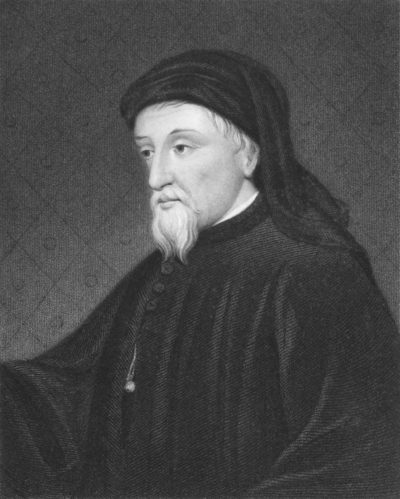More decades ago than I care to count, I was assigned to read “The Canterbury Tales” for a high school English class. That was before email and texting reduced the English language to rubble, and yet I still found it hard going. That is, until my mom, who majored in English at the University of California, Berkeley, read the Prologue aloud to me the way she said it would have sounded in the original Middle English.
I was transfixed by the rhythm and flow of the sentences and the sing-songy sound of each line. I had no way of knowing whether my mom’s pronunciation was correct or whether the timbre of her voice was appropriate, but that moment remains etched in my memory. It was as if she had opened a door to a world I hadn’t known existed. She made the 14th-century text accessible in a way it hadn’t been for me until then. (A couple of years ago, when my daughter was still in elementary school, I asked my mom to read the Prologue to her, too, and the photo I took of them immersed in the text is one I will always treasure.)
Recently I stumbled across an app that lets people hear “The Canterbury Tales,” written by Geoffrey Chaucer, in Middle English. (Pause here to consider how Chaucer’s mind would be blown knowing that his medieval poem can now be listened to on a 21st-century portable device.)
A team led by the University of Saskatchewan in Canada released it in 2020, and the university claims it is the first major literary work, in any language, developed as an app. Accompanying the reader’s sonorous voice is a digitized version of the original text, with each line highlighted with the words in print — the Middle English version on top and modern English below.
The sound of words

Chaucer began writing the “The Canterbury Tales” around 1387. The manuscript, which he didn’t finish, was published the year he died, in 1400. It is recognized as the first English-language poem, published at a time when poets wrote in French and Italian and thus were read only by the educated, wealthy members of society.
But Chaucer’s use of Middle English made it accessible to everyone; it was meant to be recited aloud, since only the elite knew how to read. (The Bible had been published in English only a few years before Chaucer started writing “The Canterbury Tales.”) And his cast of characters — a motley group telling stories as they head out on a springtime pilgrimage to the shrine of Saint Thomas à Becket in Canterbury — gives modern readers a taste of life in medieval England.
You can find oral versions of “The Canterbury Tales” all over the Internet, but the app created by the University of Saskatchewan’s team is a cut above the rest. Listening to it is an immersive, almost hypnotic experience. Perhaps that’s because the reader, former university student Colin Gibbings, sounds like he’s doing more than just reading off a page; he’s clearly transmitting his enthusiasm for the work and understanding of what’s being said. You can tell from the timbre of his voice that he’s relishing the fullness of the language in each line. The result is a retelling of a 620-year-old work that sounds lyrically and musically interesting:
Whan hath Aprill, with his shoures soote (When that April, with his showers sweet)
The droghte of March has perced to the roote (Has pierced the drought of March unto the root)
And bathed evrye veyne in swiche lyquor (And bathed every vein in that liquor)
Of which vertu engendered is the flour (Out of whose strength engendered is the flower)
Inspired hath in every holt and heath (Has breathed to life, in every copse and heath)
The tendre croppes, and the yonge sonne (The tender shoots, and when the young sun)
Hath in the Ram his halfe cours yronne (Has in the Ram his half-course run)
And smale foweles maken melodye (And small fowles make their melody)
That slepen al the nygtht with open lye (That sleep all through the night with open eye)
So priketh hem nature in hir courages (For Nature pricks them so in their ‘courages’)
Thanne longen folk to goon on pilgrymages (Then folk long to go on pilgrimages)….
The text is still a bit of a struggle to get through, even with the modern English translations underneath the Middle English. But listening to it aloud in this version highlights the richness of the language, especially in the character descriptions:
A knyght ther was, and that a worthy man (A knight there was, a most important man)
That fro the tyme that he first bigan (Who from the moment that he first began)
To ryden out, he loved chivalrye (To ride abroad had loved all Chivalry)
Trouthe and honour, fredom and curteisye (Loyalty and glory, freedom and courtesy)
Ful worthy was he in his lordes werre (He’d fought successfully in his lord’s wars)
And thereto hadde he rydden, no man ferre (And ridden thence, no other man so far)
As wes in cristendom as hethenesse (In Christendom and heathen regions too)…
Reading your writing out loud
Just as “The Canterbury Tales” made poetry available to the masses, this app makes it available to people everywhere who strive to make their writing sing. Middle English, considered vulgar in Chaucer’s time, can sound beautiful when read aloud today.
When we write, we subconsciously read silently, but what we really need to do is read our work aloud — not sentence by sentence as we’re writing, because that tortures each word and renders it lifeless — but when we think we’re near our final draft. That’s when we catch awkward phrasing, a misplaced word, a cliché that makes us grimace.
If we orient our work to be read aloud, if our voices rise and fall, slow down and speed up in the right places — if we’ve written a story that can be read with the brio of this app — then we know we’ve completed something memorable, even if it won’t necessarily be remembered 620 years from now.
***
Lisa Grace Lednicer is the local night editor of The Washington Post and an adjunct journalism professor at the University of Maryland.



